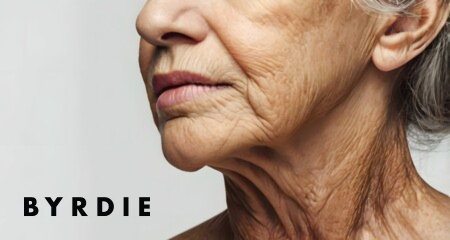As Featured in Byrdie

In a recent feature for Byrdie, I had the chance to weigh in on a skin concern I hear about from patients all the time: crepey skin. Unlike deeper wrinkles, crepey skin shows up as thin, finely textured skin that often feels fragile, most commonly on the arms, chest, neck, and even the knees. It’s something many of us notice with time, and while it’s completely normal, there are things you can do to visibly improve it.
In the article, “How to Get Rid of Crepey Skin: 12 Expert-Approved Methods,” I shared some of the same guidance I give in my office. Below is a deeper dive into those tips, plus a few additional insights I’ve seen make a real difference for patients.
1. It’s Not About Perfection. It’s About Consistency
One of the biggest things I tell my patients is this: Don’t get caught up searching for the “perfect” product. Instead, focus on the small things you can do consistently. Using a body lotion that includes powerhouse ingredients like hyaluronic acid and peptides helps support skin hydration and signals the production of collagen and elastin. When you stick with it and pair it with smart habits like gentle exfoliation, you’ll absolutely start to notice your skin looking and feeling stronger.
2. Exfoliate Gently, and Do It With Purpose
People are often afraid to exfoliate thinning or delicate skin, but the right kind of exfoliation can be incredibly helpful. I usually recommend enzyme-based or PHA (polyhydroxy acid) formulas because they’re gentle, non-irritating, and great for aging skin. When used a couple of times per week, exfoliation can help clear away dead skin cells and improve the absorption of your treatment products. It’s all about supporting, not stressing, your skin barrier.
3. Support Your Skin from the Inside Out
Topicals are important, but so is what’s happening internally. A nutrient-dense diet rich in vitamin C, zinc, and amino acids can go a long way in helping your skin stay firm and elastic. I often recommend foods like citrus, leafy greens, bone broth, and lean proteins. For some people, a high-quality collagen peptide supplement can be a great addition. And don’t forget water. Dehydrated skin tends to look crepey faster, especially in drier climates.
4. Treat Your Body Like You Treat Your Face
We give our faces so much love, but crepey skin often shows up first on the body. Think upper arms, thighs, and chest. These areas deserve the same attention. One of my favorite tips is to apply your body lotion right after showering, while your skin is still a bit damp. This helps seal in hydration and makes your products work harder for you.
5. Bring Skin Cycling to the Body
Skin cycling has become a popular concept in facial care, and it’s something I love recommending for the body as well. Think of it like this: exfoliation one night, active ingredients like retinol the next, followed by hydration and recovery. Rotating your products this way gives your skin the time it needs to respond and repair, without getting overwhelmed or irritated.
6. Focus on High-Movement Areas
Areas like the elbows, knees, and neck are constantly in motion, which makes them more prone to crepiness. These spots benefit from thicker creams, richer textures, and sometimes even in-office treatments like microneedling or radiofrequency. In my practice, I always tailor treatment plans based on lifestyle, movement, and the unique needs of each area. A little targeted TLC can go a long way!
7. For More Dramatic or Lasting Results, Surgery May Be an Option
While topical products and non-invasive treatments are often enough to improve mild to moderate crepiness, there are cases where surgical intervention offers the most reliable, long-lasting outcome. In my practice, I may recommend procedures like arm lifts, thigh lifts, or skin tightening surgery for patients dealing with significant skin laxity that isn’t responding to at-home care. These procedures are especially helpful when crepey skin is accompanied by skin redundancy or sagging from weight loss or aging.
Surgical solutions aren’t for everyone, but for the right patient, they can dramatically restore firmness and contour. If you’re considering this route, we’ll always start with a thoughtful consultation to review your goals, anatomy, and lifestyle so we can decide together what will be the safest and most natural-looking option.
Crepey skin is a natural part of the aging process, but that doesn’t mean we can’t support our skin and help it look its best. The truth is, results come from small, intentional habits done consistently. Be patient, be kind to your skin, and give it what it needs to thrive.
You don’t need to overhaul your routine. Just start with one or two steps and build from there. With the right strategy, your skin will feel stronger, smoother, and more radiant over time.
Xo,
Dr. G
